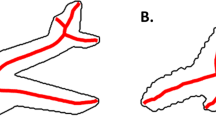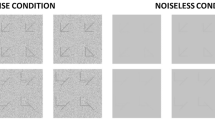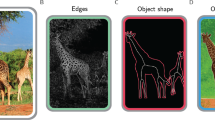Abstract
AN unsolved problem of biology is the processing of global shape in natural vision. The known processes of early vision are spatially restricted (or local) operations, and little is known about their interactions in organizing the visual image into functionally coherent (or global) objects. Here we introduce a human psychophysical method which allows us to measure the effect of perceptual organization on the activity pattern of local visual detectors. We map differential contrast sensitivity for a target across regions enclosed by a boundary. We show that local contrast sensitivity is enhanced within the boundary even for large distances between the boundary and the target. Furthermore, the locations of maximal sensitivity enhancement in the sensitivity maps are determined by global shape properties. Our data support a class of models which describe shapes by the means of a medial axis transformation1–3, implying that the visual system extracts ‘skeletons’ as an intermediate-level representation of objects. The skeletal representation offers a structurally simplified shape description which can be used for higher-level operations and for coding into memory.
This is a preview of subscription content, access via your institution
Access options
Subscribe to this journal
Receive 51 print issues and online access
$199.00 per year
only $3.90 per issue
Buy this article
- Purchase on Springer Link
- Instant access to full article PDF
Prices may be subject to local taxes which are calculated during checkout
Similar content being viewed by others
References
Blum, H. in Models for the Perception of Speech and Visual Form (ed. Wathen-Dunn, W.) 362–380 (MIT Press, Cambridge, USA 1967).
Blum, H. Perspect. Biol. Med. 10, 381–408 (1967).
Blum, H. J. theor. Biol. 38, 205–287 (1973).
Gabor, D. J. IEE Lond. 93, 429–457 (1946).
Marcelja, S. J. opt. Soc. Am. 70, 1297–1300 (1980).
Field, D. J., Hayes, A. & Hess, R. F. Vision Res. 33, 173–193 (1993).
Kovács, I. & Julesz, B. Proc. natn. Acad. Sci. U.S.A. 90, 7495–7497 (1993).
Polat, U. & Sagi, D. Vision Res. 33, 993–999 (1993).
Polat, U. & Sagi, D. Vision Res. 34, 73–78 (1994).
Lamme, V. A. F. Invest. Ophthal. vis. Sci. 35, 1489 (1994).
Zipser, K., Lee, T. S., Lamme, V. A. F. & Schiller, P. H. Invest. Ophthal. vis. Sci. 35, 1973 (1994).
Blum, H. & Nagel, R. N. Pattern Recogn. 10, 167–180 (1978).
Koenderink, J. J. & van Doom, A. J. Biol. Cyb. 53, 383–396 (1986).
Kimia, B. B., Tannenbaum, A. R. & Zucker, S. W. Int. J. comp. vis. (in the press).
Burbeck, C. A. & Pizer, S. M. Invest. Ophthal. vis. Sci. 35, 1626 (1994).
Grinvald, A., Lieke, E. E., Frostig, R. D. & Hildesheim, R. J. Neurosci. 14, 2545–2568 (1994).
Tolhurst, D. & Barfield, L. Vision Res. 18, 951–958 (1978).
Author information
Authors and Affiliations
Rights and permissions
About this article
Cite this article
Kovács, I., Julesz, B. Perceptual sensitivity maps within globally defined visual shapes. Nature 370, 644–646 (1994). https://doi.org/10.1038/370644a0
Received:
Accepted:
Issue Date:
DOI: https://doi.org/10.1038/370644a0
This article is cited by
-
Gestalts at threshold could reveal Gestalts as predictions
Scientific Reports (2021)
-
Skeletal descriptions of shape provide unique perceptual information for object recognition
Scientific Reports (2019)
-
Seeing what is not seen
Phenomenology and the Cognitive Sciences (2018)
-
Assessment of human perceptual sensitivity to physically non-conforming motion in virtual environments
The Journal of Supercomputing (2014)
-
On Seeing: Remarks on Metzger’s Laws of Seeing
Axiomathes (2011)
Comments
By submitting a comment you agree to abide by our Terms and Community Guidelines. If you find something abusive or that does not comply with our terms or guidelines please flag it as inappropriate.



